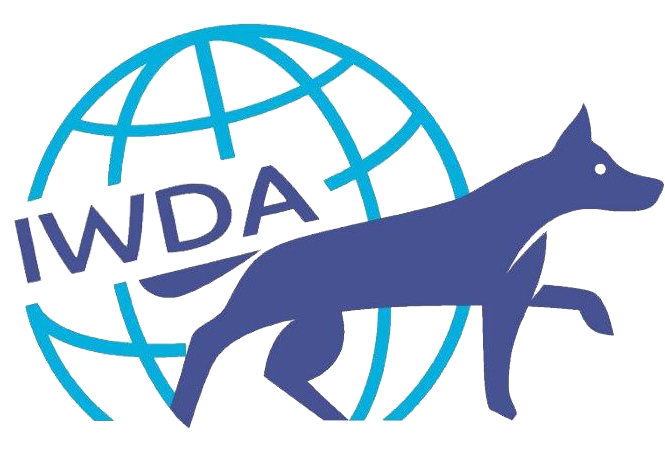Search for working dog conference recordings, articles on health, breeding, socialization and organizational management, webinar recordings and more.
Old Conference Archive Page | View all IWDC 2023 Recordings | View all Breeder's Workshop Colorado Recordings
-
Organization Management
-
Canine Resources
-
-
-
- Emotional Conflict During Socialization
- What is environmental enrichment?
- Distance, Distraction and Duration
- Developing Foundational Skills
- Luring, Marking & Giving Food
- 5 Steps to Progressing Skills
- Dog-Human Relationship Skills
- Utilizing Volunteers
- Biosecurity
- Biosecurity protocol documents
- Example Socialization Schedule
- Puppy Socialization Tracker
- Crate Training
- Managing Inappropriate Interactions between littermates
- Preventing and Fixing Door Dashing
- Follow Me: Video
- Bath Progression: Video
- Intro to New Environments: Video
- Motor Development: Video
- Novel Objects: Video
- Novel Sounds: Video
- Trolley Ride: Video
- Wearing Things/Coat Desensitization: Video
- Carrying Puppies Safely
- Safely Using Stairs: Video
- Puppy Confidence Course
- Socialization Ideas Gallery
- Show Remaining Articles ( 12 ) Collapse Articles
-
- Articles coming soon
-
Education
-
-
- A Behavioral Questionnaire for Selection and Study of Odor Detection Dogs - Presented by Cynthia Otto
- Audeamus PTSD Service Dogs, ACAC Accredited Peer-Support Model for Veterans and First Responders - Presented by Chris Lohnes and Grace Rath
- Audeamus Service Dogs and University of Saskatchewan Research Partnership and Outcomes - Presented by Chris Lohnes & Grace Rath
- Building a Purpose Bred Breeding Program - Presented by Allison Peltier and Rachel Goldammer
- Core body temperature and activity level changes during work and exercise in patrol dogs of the Queensland Police Service - Presented by Jayne McGhie
- Detection of Heterobasidion parviporum scent samples in indoors scent discrimination test by trained volunteer dog-handler teams - Presented by Heli Väätäjä
- Development of a Tool to Aid in the Selection and Pairing of Breeders based on Behavioral Traits - Presented by Jordan Smith
- Early Detection of Heat Stress in Working Dogs - Presented by Andrea L. Henderson
- Effects on behavior and physiology of handling style during veterinary visits - Presented by Karen Overall
- Field cooling for exertional hyperthermia - Presented by Cynthia Otto
- From Anxious to Resilient: The Role of Dynamic Interactive Engagement in Shaping Military Working Dogs - Presented by Melanie Uhde
- Genetic Resources to Improve Dog Health - Presented by Angela Hughes (Royal Canin)
- Genomic research in the Working Dog Field: Combating Canine Cancer through Collaboration and Comparative Oncology Research - Presented by Frances L. Chen
- Handler Perceived Risks to Operational Detection and Patrol Police Dogs - Presented by Jayne McGhie
- Improving Trauma Patient Care - Presented by Kelly Hall
- Neuromuscular Balance Training in Working Dogs - Presented by Andrea L. Henderson
- Occupational Risks and Specialized Veterinary Care for Working Dogs - Presented by Cynthia Otto
- Putting working dog research into practice: development of science-based guidance notes - Presented by Fiona Williams
- Rating of Perceived Exertion in Working Dogs - Presented by Andrea L. Henderson
- Real-world experience with liquid biopsy testing for cancer detection in working dogs - Presented by Jill Rafalko
- Specialty Practice Behavioral Problems and Outcomes in Companion Dogs - Implications for Working Canines - Presented by Walt Burghardt
- Start of life – Feeding during pregnancy and lactation to increase reproductive success - presented by Angela Hughes (Royal Canin)
- Teaching Collar Yielding as a Foundation Behavior - Presented by Patrick Glines
- The Doberman Diversity Project: a Citizen Science approach to breed improvement - Presented by Sophie Liu
- The effect of inhibitory control, arousal, and affective state in Military Working Dogs Performance - Presented by Astrid Concha
- The effect of training aid volume on odor generalization in detection of chronic wasting disease in deer - Presented by Mallikarjun and Wilson & Cindy Otto
- The Many Dogs Project: A Big Team Canine Science Effort - Presented by Sarah-Elizabeth Byosiere
- Transformative Power of Freedom of Choice in Changing Behavior - Presented by Marty G. Roache
- Turning a Critical Eye on an Established Breeding Program to Improve End Results Using IWDR - Presented by Natalie Ergler and Rachel Goldammer
- U.S. Military Working Dog Welfare - Presented by Desireé Broach
- What is the future of Biological Detection Canines? - Presented by Heather Junqueira & Ken Furton
- Working dog memory and canine gut microbiome - Presented by Xu Wang
- Show Remaining Articles ( 17 ) Collapse Articles
-
- Breeding Healthy Dogs - Presented by Madeline Zimmermann
- Choosing What to Breed For - Presented by Madeline Zimmermann
- Gaiting - with Doug & Colton Johnson
- Genetic Merit Selection - Presented by Madeline Zimmermann
- Improving Behavior - Presented by Jane Russenberger & Dr. David Roberts
- IWDR: Storing your Data - Presented by Rachel Goldammer
- Keep Data on Everything! - Presented by Rachel Goldammer
- Long-Term Colony Management: Balancing genetic improvement breeding for the whole dog - Presented by Dr. Eldin Leighton
- Power of Numbers: IWDR Functions - Presented by Rachel Goldammer
- Producing Puppies - Presented by Dr. Fiona Hollinshead and Dr. Greg Burns
- Puppy Socialization - Presented by Jane Russenberger
- Puppy Socialization for Handling - presented by Doug & Colton Johnson
- Reading Dog Behavior/Emotional States - Presented by Dr. Karen Overall
- Whelping and Neonatal Care - Presented by Dr. Fiona Hollinshead and Dr. Greg Burns
-
- "All about the boy" - Semen Collection and Analysis - presentation by Dr. Fiona Hollinshead
- All about the brood - presentation by Dr. Greg Burns
- Behavior Checklist (BCL) Workshop - with Helen West
- Behavioral scoring in Puppy Raising - presentation by Helen West
- Brood and Whelping Concerns - presentation by Dr Greg Burns
- Calculating Differential Risk of Osteoarthritis in Dogs with Low vs High Hip Scores - presentation by Dr Tom Lewis
- Cardiac diseases - presentation by Dr Kevin Conrad (absent); presented by Dr. Kyle Quigley
- Conditioning Program for Dogs Coming In For Training - presentation by Dr Kevin Conrad (via zoom)
- Critical periods of socialization and impact on temperament of the dog - presentation by Jane Russenberger
- Does early potty training affect indiscriminate relieving? - presentation by Dr Lynna Feng
- Dog behavior is in the eye of the beholder - presentation by Joke Monteny
- Entropion - presentation by Jenna Bullis
- Feeding for Breeding Success - presentation by Dr. Emmanuel Fontaine
- Gait and Structure Evaluation for Guide Dogs - presentation by Peggy Gibbon and Dr Katy Evans
- GDBart Puppy Test - presentation by Helen West
- Healthy microbiome and faecal transplants - presentation by Dr Kevin Conrad (absent); presented by Dr Caroline Moeser
- Hip and elbow assessments - with Dr Bart Broeckx
- How to make breeding decisions on traits without EBVs - presentation by Madeline Zimmermann
- How to use estimated breeding values successfully - presentation by Madeline Zimmermann
- Improving behavior with EBVs: Body sensitivity, Noise Fear, Inhibited by Stress, Activated by Stress, Excitable - presentation by Jane Russenberger
- Improving health using EBVs: Elbow, Skin and Mast cell tumours - presentation by Madeline Zimmermann
- Is it really epilepsy? - with Dr Bob Proesmans & Dr Caroline Moeser
- Neonatal Care - presentation by Dr Emmanuel Fontaine
- Reproductive Trends and Cryogenic Insights from Guiding Eyes - presentation by Clover Williams
- Selecting Reproductively Healthy Dogs - presentation by Dr Emmanuel Fontaine
- Skin allergies - with Dr Caroline Moeser
- Stargardt's disease in Labrador retrievers - with Dr Katy Evans
- Strategies for genetic diversity - presentation by Jackie Clark and Dr Bart Broeckx
- Superficial Digital Flexor Tendon Avulsion - presentation by Dr Caroline Moeser
- The art of insemination - presentation by Dr. Fiona Hollinshead
- The Overall Selection Index - presentation by Dr Eldin Leighton
- What influences semen quality? - presentation by Dr. Tom Lewis
- Show Remaining Articles ( 17 ) Collapse Articles
-
- A detailed evaluation of Spotted Lanternfly (Lycorma delicatula) detection dog training and performance - Presented by Edgar O. Aviles-Rosa
- A novel method for the detection of Japanese knotweed (Reynoutria japonica) using specially trained canines - Presented by Kat Janczur
- AKC Detection Dog Task Force Program: Working with AKC Breeders to Improve Breeding & Availability of Explosives Detection Dogs - Presented by S Goffe
- Assessing working dog fitness with the Penn Vet Working Dog Center Fit To Work program - Presented by Brian Farr
- Assessment of the Agreement between Fosters and Trainers Evaluating Behavior with the C-BARQ and Behavior Checklist presented by Elizabeth Hare
- Behaviour Assessment and IWDR - Presented by Dr Jane Russenberger
- Breeding Strategies and Advanced Reproductive Techniques to Optimize Production of Improved Generations of Specialized Canines at Three major working dog breeding programs in New Zealand - presented by Dr Fiona Hollinshead
- Development and heritability of cognitive traits in Canine Companions dogs presented by Emily Bray
- Digital innovation for working dogs - Presented by Dr Mia Cobb
- Discrimination between SARS-CoV-2 infection and other viral respiratory infections by working dogs - Presented by Nele ten Hagen
- Effect of impulsivity and core effect on training performance in dual purpose military working dogs - Presented by Astrid Concha
- Epilepsy in working dogs - Presented by Prof Holger Volk
- Estimated Breeding Values in IWDR - Presented by Dr Eldin Leighton
- Examining the Role of Significant Others in Canine Welfare within the Context of Veterans Working with Service Dogs - Presented by Linzi Williamson
- Explosive detection canine operational requirements and performance degradation: expert perspectives - Presented by Brian Farr
- Hot Topics in Working Dog Care - Presented by Dr B. Pierce & Dr K. Mann
- Implementation of a plan to decrease arousal and increase motivation - Presented by Robert Dougherty Jr and Alena Heyer
- Improving behavior monitoring within a working dog program - Presented by Becky Hunt
- Incidence of enteric pathogens versus presence of gastrointestinal symptoms in a working dog training facility - Presented by Dr Nicola Cotton
- Investigation of tail injury at Lackland Air Force Base Training Kennels for Military Working Dogs - Presented by Marty G. Roache & Karen L. Overall
- Learning to Smell: Impacts of Training and Experience on Detection Dog Performance - Presented by Nathaniel Hall
- Lecture on Generalization in Detection Work - Presented by Hans Ebbers
- Liquid biopsy screening for early cancer detection in working dogs - Presented by Katherine M. Lytle, DVM, MPH, MS
- Military Working Dog Aggression and Welfare - Presented by Desiree Broach
- Multimodal characterization of detection dog suitability: Combining behavioral, cognitive, and neurological measures for enhancing selection - Presented by Lucia Lazarowski
- Overview of the IWDR for Working Dog Organizations - Presented by Dr Eldin Leighton
- Pandemic or pandemonium? Creating standards for medical detection dogs - Presented by Dr Cynthia Otto
- Penn Vet Working Dog Center Fit To Work program foundational fitness development and training - Presented by Meghan Ramos
- Preliminary Accuracy of COVID-19 odor detection by canines - Presented by Kenneth G. Furton
- Prevalence of Canine Degenerative Myelopathy SOD-1 Mutation in Working Shepherd Dogs across Australia and New Zealand - Presented by Jayne McGhie
- Scent dog identification of SARS-CoV-2-infections- a double blind study - Presented by Esther Schalke
- Solving cold-cases: Dogs can match human scents collected several years apart - Presented by Margot Perez
- The Application / Practical Implementation Pro/Cons of Covid-19 Olfactory Detection Dogs - Presented by Prof D Grandjean
- The Domestic Breeding Consortium: Odor Detection Canine Selection, Breeding, and Early Training Techniques - Presented by Karen Meidenbauer
- The effect of maternal style on later puppy behavior in Canine Companions dogs - Presented by Brenda Kennedy
- The use of historical health records at The Seeing Eye in genome-wide association studies for canine health traits presented by Katy M. Evans
- Training with Varying Odor Concentrations: Implications for Odor Detection Thresholds in Canines - Presented by Mallory DeChant
- Transitioning a Therapy Dog Program Online: What's In It For the Dog? - Presented by Ben Carey
- Using IWDR's Advanced Tools to Improve HeaLth and Behaviour - Presented by Dr Eldin Leighton
- Using Single-Step Genomic BLUP to Compute Genomic Enhanced Breeding values for Self-Modulation in Working Dogs presented by Molly Riser
- Using trained dogs and organic semi-conducting sensors to identify asymptomatic and mild SARS-CoV-2 infections - Presented by Dr Claire Guest and Prof James Logan
- Working Dog Welfare: Where are we now and where are we going? - Presented by Dr Mia Cobb
- Show Remaining Articles ( 27 ) Collapse Articles
-
- A canine thermal model for mitigation of heat strain in working dogs - Presented by C. O'Brien
- Building a better detector dog: Lessons learned and (many) questions remaining to be explored in Auburn University’s 19 years of detector dog production - Presented by P. Waggoner, PhD
- From Puppyhood to Adolescence: Longitudinal Cognition Study at Canine Companions for Independence - Presented by K. Levy
- Genome-wide association studies to identify loci and variants associated with behavioral traits in dogs - Presented by V.D. Marinescu, PhD
- Hyper-reactivity in military working dogs: a report of two cases - Presented by O. Soares, DVM, PhD
- Measuring, and determining factors affecting performance of glycemic alert dogs - Presentation by N. Rooney, PhD
- Neuromotor development in puppies: implications for training and fitness - Presented by B. Pierce, DVM, MS, DACVIM, DACVP, DACVSMR
- Odour generalisation – theory and practice - Presented by A. Schoon, PhD
- Putting working dog research into practice: development of science-based guidance notes - Presented by V. Ratcliffe, PhD
- Referential focus - pet & working dogs - Presented by K. Overall, MA, VMD, PhD, DACVB
- Statistics for working dogs – how do you know if your test/assessments are better than a coin toss? - Presented by A. Dunham, PhD
- Temperament and EBV - Presented by Erling Strandberg, PhD, SKK
- Testing dogs for behaviour in Sweden: Canine temperament - assessment and heritability & How you assess temperament - presented by Åke Hedhammar DVM, PhD & Kenth Svartberg, PhD
- The chemistry of odor: How understanding odor can foster a better detector - Presented by L. De Greeff, PhD
- The opioid crisis and working dogs - Presented by C. Otto, DVM, PhD, DAVCECC
- What helps and what hinders assistance dog/puppy raising practices? - Presented by Doc Loc Mai (Jimmy)
- Working Dog Centre: Working hard for working dogs - Presented by W. Baltzer, DVM, PhD
- Show Remaining Articles ( 2 ) Collapse Articles
-
-
-
-
Payment and Accounts
Weeks 1 & 2
0 out of 5 stars
| 5 Stars | 0% | |
| 4 Stars | 0% | |
| 3 Stars | 0% | |
| 2 Stars | 0% | |
| 1 Stars | 0% |
Quick Reference Guide

Goal
Begin building positive associations to the world! Introduce passive sounds, surfaces, novel objects & body handling to begin building pup’s resilience.

Environments
Whelping box or room that the litter is housed. Interactive activities can be done in a separate clean room, or in the den area with an accepting brood.

Volunteer Activities
Puppy massage and passive environmental enrichment can be done by experienced volunteers or staff – make sure your brood is comfortable.
Introduction
During these first weeks of life the pups are introduced to this world that they will share with humans. Pups enter this world as blank canvases and our job is to provide a den that is both interesting and challenging.
The pups’ sense of touch and scent are beginning to develop during the first two weeks. A few additions to the den can help create a solid foundation to the start of puppies’ early socialization. A den that provides many scents, textures and movements/vibrations will start to fill in the blank canvas. The pups will start to build up a memory bank of positive experiences and associations around many different things.
- Pup is accepting of handling without wiggling, yawning or huffing.
- Pup is accepting of its environment without overreacting.
- Brood is happy and settled while humans interact with her pups.
- As they begin to move about more, puppies explore and interact with the items and are comfortable in a changing environment.
- Monitor both puppies’ and broods’ body language: be prepared to stop, re-assess and build up again if the puppy is uncomfortable.
- Keep it brief: start slowly and build up: start with one minute. More does not produce better results – quality over quantity.
- Keep your objective in mind: pups will develop positive associations to body handling, build handler engagement, and experience different textures from materials like the scales, staff scrubs and the whelp mat.
- Allow the puppy an escape route at all times: At this age pup will communicate by trying to move away. Place the puppy back with its mother for comfort and try again later.
- As puppies’ eyes and ears open, they will begin to notice their environment. Watch as their motor skills continue to improve and puppies are able to explore and interact with their world.
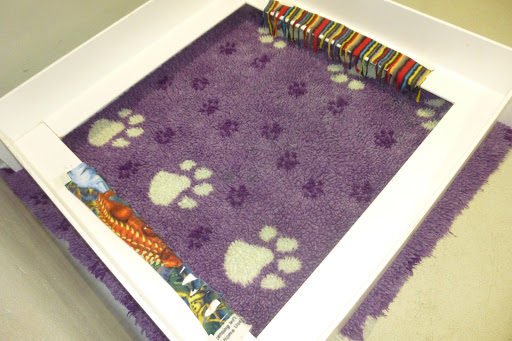
Problem Solving
Has time been spent with the Brood prior to her Whelping in order to build up positive associations? Pre-whelp is a good time to massage the Brood especially around her side and towards her glands where pups will feed. Relaxation music can be helpful as well as introducing the Brood to the initial sounds her pups will experience once their ears open. Once you know how your brood is likely to react for future litters, spend additional time with her in the pre-whelp stage preparing her for the weeks ahead.
Your brood will need to leave the den briefly to toilet, stretch her legs or eat – use this opportunity to work on some socialization activities or re-arrange the passive environmental enrichment stimuli in the den.
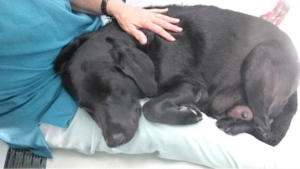
- Review our massage and body handling protocols. Make sure you’re not progressing too quickly. Ensure that the massage is no longer than 1 minute. Reduce time then slowly build up again.
- Are pups touched prior to being lifted off ground for weighing? Petting the pup before handling can help avoid startling the pup.
- Ensure all staff move pups slowly and each pup is fully supported. Make sure not to move pups quickly through the air.
- Place another pup next to the pup being massaged for a familiar scent.
- Use a small piece of whelping mat that has been left under puppies. Familiar scent will be on the massage whelping mat.
During these early weeks, you can encourage mom to come near the puppies. If puppies continue to show stress signs, move puppies closer to their mother and littermates.
If puppies are regularly “getting lost” or “stuck” away from mom and littermates, you may have too many passive environmental enrichment items in the den. Reduce the number of items or the complexity of the environment.
Passive Environmental Enrichment
Our goal is to begin to slowly introduce passive sounds, surfaces, and novel objects. Begin to introduce age-appropriate environmental enrichment and one different environment. We also want to continue to make body handling a positive experience.
Below we have marked each activity with one to three ✓. Although all activities are important, we have highlighted activities that are particularly critical during this period of the puppies’ development. Make sure you still offer the pups a wide variety of activities and do not only focus on those with the most ✓!
Different surfaces can be added to the whelping box for an hour each day as long as the Mom is comfortable with the objects and will still continue to take care of the puppies.
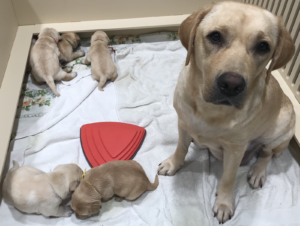
Fabric around the edge of the whelping box will enable passive desensitization. Remove the fabric at night if the den is not supervised.
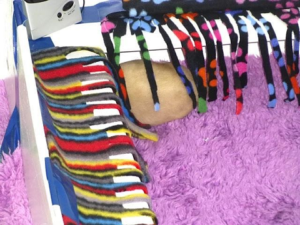
During the second week, the puppies’ eyes begin to open. As their vision develops, different shapes and patterns are beneficial. Wall decals or wallpaper with different shapes and objects can be applied to a wall in the litter’s room. Many decals are labelled to be easily applied and removed and can be easily rotated to add variety.
In preparation for when the puppies’ ears open up, prepare the brood so she is familiar with different sounds, as well as sounds coming from different directions.
Music- Think variety. Jazz, Classical, Country, Weather, etc. Music can be played quietly on a radio, or computer in the same room as the whelping box for half an hour per day. Safe objects that make noise can also be placed in the whelping box. If Mom is uncomfortable with items or will chew items up, only place them in the den under supervision for a short period of time.
The puppies’ sense of smell is developed from birth in order to find their mother for food. Use these early weeks to introduce new scents, and move the scent box around the den to provide some directional variety.
If your program finds certain scents are a common concern in puppy program or training, these scents or milder versions can be introduced to puppies in the scent box if they are non-toxic. For example, if the training department reports that bird feathers along their routes are a common concern, down feathers can be placed inside the scent box. Milder versions of scents such as liquid used for candles or soaps can be added to a cotton ball and placed in the scent box. A little goes a long way with scents, only a drop or two of the liquid is needed.
Do not use strong fragrances, instead use light and calming essential oils or similar. Remove at night if the den is not supervised.
If the brood is not able to have a scent box in the whelping box, one can hold the scent box and walk through the room.
Interactive Activities
The activities below can be done in a clean room or right outside of the whelping box. If done in a separate room, make sure Mom goes along to support the puppies.
Below we have marked each activity with one to three ✓. Although all activities are important, we have highlighted activities that are particularly critical during this period of the puppies’ development. Make sure you still offer the pups a wide variety of activities and do not only focus on those with the most ✓!
Acceptance of body handling is a skill that is introduced during the first week. The pup needs to build positive associations around handling all parts of its body. To achieve this we use massage. Age appropriate massage will only last 1 minute for the first 7 days.
Body massage Protocol
- Pup is placed on its stomach on a soft towel in your lap. Take two fingers and start massaging in a very small circle. Massage both body and appendages. Remember not to massage pups ears yet as they are not opened – leave ear massage until 2 weeks of age.Tip: If the puppy is calm, use clockwise circles. If a puppy is finding it difficult, use counterclockwise circles.
- Slowly turn the puppy onto its side and continue massaging. This stage is only initiated if the puppy is accepting this change in position. STOP here if the puppy is communicating signs of distress such as a large yawn, whimpering or excessive wiggling.Note: If the puppy is not showing signs of distress, slowly turn the puppy onto the other side and continue the small circle massage.
- Slowly return the pup so it is on its stomach and continue the small circle massage.
- Finish off with long smooth movements across the body.
As puppies grow, it is important to introduce them to positive body handling. One way to accomplish this is with massage. Below is the age- appropriate amount of time per puppy.
| Age of Puppy | Time |
| 0-7 days | 1 minute |
| 8-14 days | 5 minutes |
| 15 days and older | 10 minutes |
- Find a slightly different environment – e.g. a nearby room.
- Place a blanket or other non-slip material on the floor where the puppies will be to help with their traction as they explore the objects.
- Pick one activity to work on at a time – e.g. introducing new surfaces or new novel objects.
- Place items on the sheet and allow puppies to explore the items without your interference. Mom should be nearby for support. Mom can interact with the items.
- Make sure to keep the activity short, no more than 15 minutes. Monitor the puppies’ reactions and stress signals and respond accordingly (for example, by encouraging mom over to provide support).
Here are some photo examples of a “room” set up:

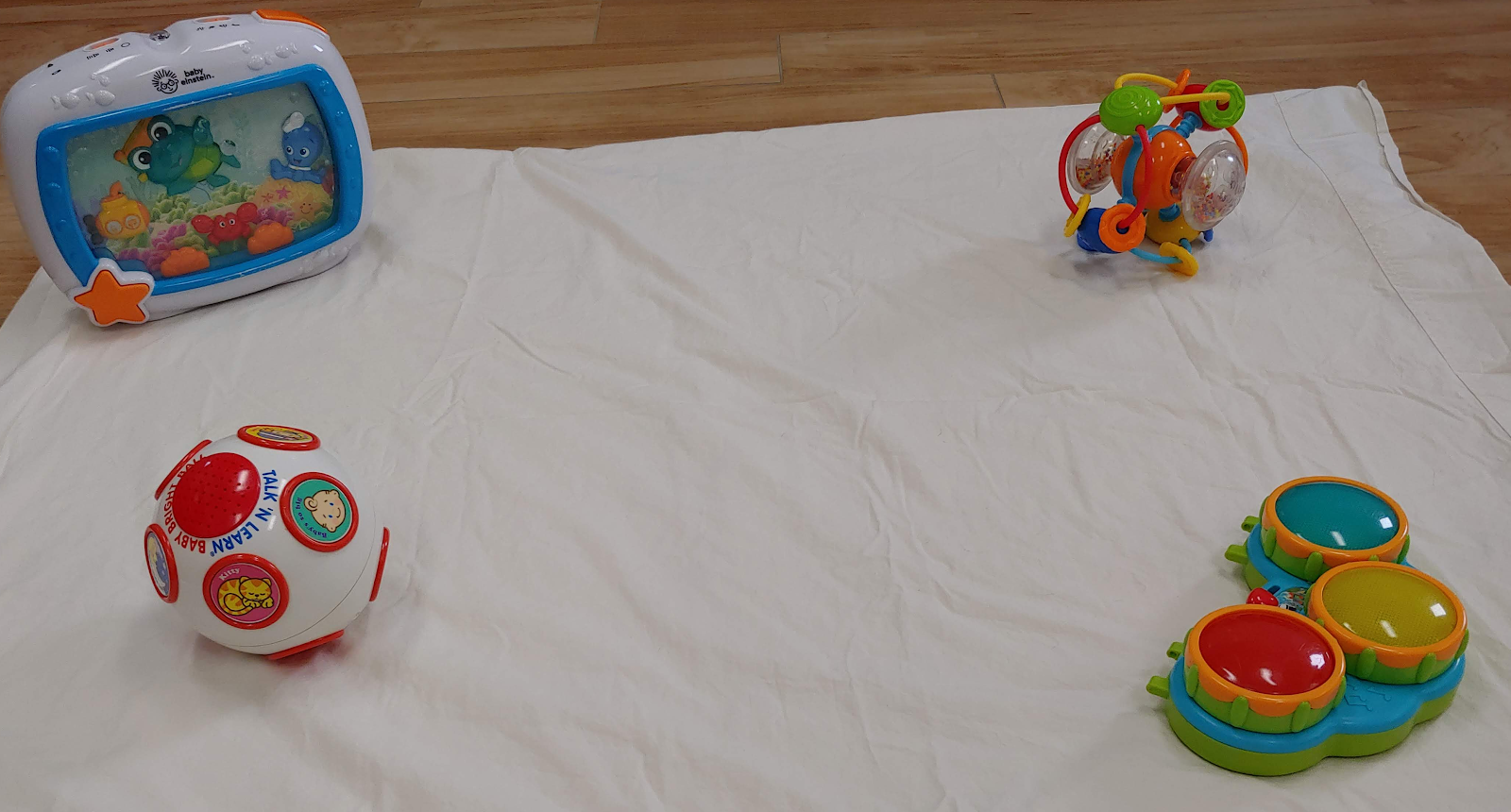
More Resources
IWDA members can access the following articles, presentations and lectures that can help you upskill and build upon your socialization program. Discover some of the science behind our Early Socialization Program. Not a member? Learn more here.
General Socialization:
- Puppy socialization for handling, presented by Doug and Colton Johnson
- Puppy socialization, presented by Jane Russenberger
- Critical periods of socialization and their impact on temperament in the dog, presented by Jane Russenberger
Measuring Behavior:
- Learn about the Behavior Check List used to systematically measure puppy behaviour, how to run a GDBART puppy test, and hone your skills in one of our recorded BCL workshops run by specialist Helen West.
Puppy socialization to improve your working dog program:
- The effects of puppy potty training on Indiscriminate relieving in training, presented by Dr Lynna Feng
- The effect of maternal style on later puppy behavior in Canine Companions dogs, presented by Brenda Kennedy
- Development and heritability of cognitive traits in Canine Companions dogs, presented by Emily Bray
- Neonatal care, presented by Emmanuel Fontaine
- These articles are relevant, but older and less content is available:
- Neuromotor development in puppies presented by Dr B. Pierce
- From Puppyhood to Adolescence: Longitudinal Cognition Study presented by K. Levy
- What helps and what hinders assistance dog/puppy raising practices?, presented by Doc Loc Mai
0 out of 5 stars
| 5 Stars | 0% | |
| 4 Stars | 0% | |
| 3 Stars | 0% | |
| 2 Stars | 0% | |
| 1 Stars | 0% |
